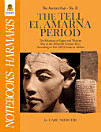The Tell El Amarna Period
About this ebook
In the beginning of 1888 some fellahìn digging for marl not far from the ruins came upon a number of crumbling wooden chests, filled with clay tablets closely covered on both sides with writing. The dusky fellows must have been not a little delighted at finding themselves owners of hundreds of these marketable antiquities, for which a European purchaser would doubtless give plenty of good gold coins. To multiply their gains they broke up the largest tablets into three or four separate pieces, often to the grievous hindrance of the future decipherer. But very soon the matter was fruited abroad; the Government at once intervened, almost all the find was in due time secured, and a stop was put to any further dispersal of separate tablets and of fragments. The political situation in Egypt is pretty accurately indicated by the fact that about eighty of the best preserved of the Tell el Amarna tablets at once found their way to the British Museum. Some sixty were left in the museum at Boulak, and about one hundred and eighty were secured for the Berlin Museum, many of them tiny fragments, but mostly containing important records. Few have remained in private hands.
Some alabaster slabs came to light at Tell el Amarna bearing the hieroglyphic names of King Amenophis IV. and his father, Amenophis III. These had evidently served as lids to the chests. Some tablets also were inscribed with notes in hieratic, written in red ink. But in spite of these exceptions, it was at once recognised that all the documents were written in Babylonian cuneiform. The reading of the introductory lines on various tablets served to show that the find consisted of part of the Egyptian state archives in the times of the two kings Amenophis III. and IV. Thus the first of the many startling discoveries that were to follow in such rapid succession was made in the recognition that about 1400B.C. the Semitic speech of Babylon served as the language of diplomacy in the East.
Apart from a few tablets dealing with mythological subjects and written in Babylonian, and two which contain inventories, all the tablets were letters. Most of them were from Egyptian officials in Syria and Canaan, and usually they wereaddressed to the king. Among them were found many long letters from Asiatic kings to the Egyptian monarch, and also a few communications from the Foreign Office of “Pharaoh” himself. We must note, however, that this title of Egyptian kings, so commonly used in the Old Testament, is apparently never once employed in the Tell el Amarna documents. It is interesting to observe how difficulties of the script and of a language not entirely familiar to most of the scribes were overcome. Even the learned scribes of the royal “House of the Sun” in Egypt had obviously their own troubles in the matter, and made use of the Babylonian mythological texts already mentioned as a means of improving their fluency. Of this we have evidence in the thin red lines by which, on these tablets alone, the words have been separated from each other. The governors and officials must not be classified as educated or uneducated on the evidence of their letters; all alike employed professional scribes, of whom one might be skilful and the next a bungler whose communications must be guessed at rather than read. Occasionally a Babylonian word is followed by the corresponding Canaanite word, also in cuneiform, but marked as a translation. Like the Egyptian kings, so the Asiatic sovereigns had each his staff of scribes. One of the petty chiefs, Tarkhundarash of Arsapi, was evidently so unhappy as to have none in his Court who could read or write a letter in Babylonian, for letters to him were written in his own tongue. The scribe of the Hittite king produced only a species of dog Latin, while the scribe of the king of Alashia trots out his whole vocabulary unhampered by grammar. On the other hand, the letters of the king of Mitani are drawn up in the characters known as Assyrian; and it is probable that the Assyrian system of cuneiform may have originated in Mitani. If so, for the Mitani scribe there could be no question of any special difficulty in using the acknowledged language of diplomacy in the Ancient East.
It is evident that the Babylonian royal scribes at length showed some consideration for their unfortunate Egyptian correspondents by writing as a rule in phonograms which could be easily spelt out, since strange ideograms might have brought the reader to a standstill. The sources of the letters may be distinguished also by the colour and consistency of the material of the tablets, which are of all shades of clay, from pale yellow to red or dark brown. Side by side, too, with hard and legible pieces, lie broken and crumbling fragments which have suffered sadly during the few years that have elapsed since they were again exposed to the air.





